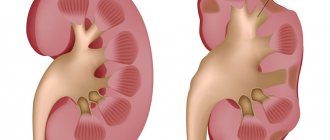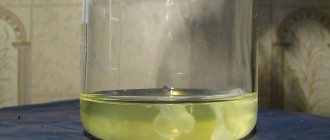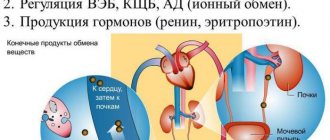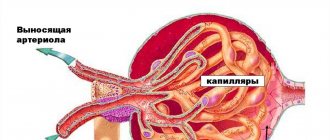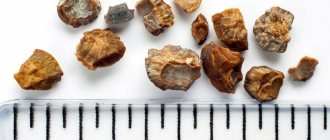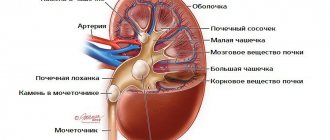Pain in the kidney area or in the kidneys themselves is one of the most unpleasant, persistent and severe, but do not despair. If you are wondering if your kidneys hurt, what to do at home, you will definitely find the answer later in the article. Kidney disease can occur for a variety of reasons, and the pain will vary. Kidney pain should not be ignored, and if it occurs, you should immediately seek advice and specialized treatment from a doctor.
How to determine kidney pain
Discomfort in the lumbar region may indicate various pathologies of internal organs.
According to statistics, in 90% of cases, problems with the spine or back muscles are detected. With nagging pain in the lower back, only 6% of patients are diagnosed with kidney disease
. Discomfort occurs due to heavy lifting, awkward posture, or sudden movement. Characteristics of pain in renal pathologies:
- The pain is unilateral: to the left or right of the spine.
- Irradiates along the ureter, to the external genitalia, groin, lateral surface of the abdomen, and to the inner surface of the thighs.
Features of pain syndrome
Kidney diseases often manifest as discomfort in the lower back and impaired urination. The pain has a different character: pulling, cutting, aching. They may be present constantly or worsen during urination. What do different types of pain indicate:
- Occurs when urinating - blockage of the urinary tract with a stone.
- Dull, nagging pain, drowsiness, skin rashes - inflammatory processes in the organ.
- Pressive pain syndrome, accompanied by dizziness, nausea, dark urine - pyelonephritis, nephropathy.
- Acute pain radiating to the lower back, bleeding during urination - hydronephrosis, nephroptosis.
- Aching pain, swelling, impaired urination - renal failure.
First aid
When your kidneys hurt badly, you need to do the following:
- Call an ambulance.
- The patient should take a horizontal position on a comfortable, flat surface, even out his breathing and try not to move.
- You can place a warm heating pad in the area of the sore spot or wrap it with a downy scarf.
Important! If the pain is unbearable, it is recommended to take a medicine that has an antispasmodic effect.
What to do for kidney pain
It is necessary to provide the person with peace, put him on the bed. Subsequent actions for kidney pain depend on the cause of its occurrence. In case of an acute attack, you must urgently consult a doctor: a urologist or nephrologist. If the pain is not severe, then you can provide first aid at home (Analgin tablet, warm drink), and then make an appointment with a doctor. The following methods are used to diagnose diseases:
- Anamnesis collection. The doctor finds out the location and nature of the pain, the duration of the attacks and other symptoms.
- Inspection. Percussion and palpation are performed. The doctor feels and taps the patient’s stomach, back, and lower back.
- Urine examination. The patient is sent for general, biochemical, bacteriological analysis and according to Nechiporenko.
- Blood test. To establish the general condition of the body and determine kidney function indicators, a general and biochemical analysis is done.
- Ultrasound of the kidneys. Based on the results of the ultrasound examination, the doctor examines the condition and structure of the kidneys, their size, structure and the presence of cysts, stones, and tumors.
Articles on the topic
- Swelling under the eyes - how to remove them with the help of drugs and folk remedies
- A woman's lower abdomen hurts - why do sharp, pulling, cutting or dull pain appear?
- Abdominal pain - why it occurs and how to relieve an attack, types by nature and intensity
Medicines to relieve kidney pain
A common mistake in kidney disease is choosing medications on your own or on the advice of friends. It is important to remember that medications that are suitable for one person may be contraindicated for another. All medications are prescribed by a doctor. They must be taken strictly in the indicated dosage. Groups of drugs prescribed for kidney diseases:
| Pharmacological group | Indications for use | Drug names |
| Broad-spectrum antibiotics | Attachment of infection. Eliminate E. coli, enterococci and other bacteria that cause inflammation. | Ciprofloxacin, Verapamil, Norfloxacin. |
| For dissolving and removing sand | Urolithiasis disease. They dissolve urates, reduce the concentration of uric acid, and facilitate the natural removal of kidney stones. | Blemaren, Urodan, Allopurinol. |
| Combined herbal remedies | Herbal preparations that have antispasmodic, diuretic, antimicrobial, anti-inflammatory effects. Prescribed for urolithiasis and urinary tract infections. | Cyston, Canephron D, Urolesan. |
Causes of urinary system dysfunction
When a person prefers fried, protein foods, ignoring fruits and vegetables that contain enzymes, amino acids and minerals necessary for normal digestion, stones are deposited in the kidneys. Include as many fresh vegetables and fruits as possible in your daily menu, and it is better if they are grown on your personal plot. Apples, apricots, watermelons and melons are especially useful.
The rate of fluid intake varies from person to person, but on average it is recommended to drink at least 2 liters of water per day, taking into account the liquid contained in food. Give preference to cranberry juice, kidney tea, fireweed, but avoid coffee and strong black tea.
As for kidney cysts, in most cases they are not dangerous. At the same time, only a doctor can answer the question of what exactly needs to be done with a kidney cyst, having assessed many parameters: its size, structure (the presence of partitions, the nature of the contents), the relationship with the collecting system, the effect on the outflow of urine, the presence pain.
Often the number of cysts is so large that they occupy the entire kidney. This condition is called polycystic or multicystic, which is more often detected by ultrasound, although the patient may not have any complaints at the time of diagnosis.
A simple cyst that is less than 4 cm in size is usually observed if it does not interfere with the flow of urine. If it is suspected that the cyst is degenerating into a malignant formation, it should be removed. This is why a specialist should monitor cysts.
Kidney injury can have serious consequences. A hematoma occurs in the injured area, and if it ruptures, the risk of bleeding is high, and urgent surgery cannot be ruled out. If the integrity of the hematoma is not broken, then observation is necessary, since cases of hematoma suppuration are not uncommon.
In addition to injuries, cysts, and urolithiasis, there are other diseases that can cause pain, including malignant neoplasms, pyelonephritis, abnormalities in the development, structure, and obliteration of the urinary tract. There are also diseases that do not cause discomfort, but are extremely dangerous: glomerulonephritis, diabetic kidney disease.
Kidney treatment at home
The main rule is to adjust the menu. During kidney treatment, you need to pay attention to the amount of fluid consumed. You should not drink anything before bedtime (2-3 hours before), and during the day you should avoid strong tea, coffee, sour fruit drinks, and juices. All alcoholic drinks are prohibited during treatment. In chronic renal failure, the volume of fluid entering the body is reduced to 1 liter per day. Will help during treatment:
- Positive emotions. Fear, fright, and depression provoke impaired functioning of the kidneys and their prolapse.
- Physical activity. Prolonged sitting leads to compression of the sciatic nerve. In this case, the blood supply to the organs of the genitourinary system is disrupted.
- Warm. To prevent kidney pain, your feet should be dry. It is advisable to visit the bathhouse more often and take hot baths, if there are no contraindications for this.
Diet for kidney pain
The diet during treatment requires adjustment. Basic diet rules:
- Reduce salt intake (no more than 5 g/day).
- Reduce the amount of protein foods.
- Eat in small, fractional portions (up to 6 times/day).
- Culinary processing of products is gentle (steamed, stewed, boiled, baked in foil).
The diet includes an expanded selection of products. You can prepare a varied menu from them. List of main permitted products:
- bread made from wheat flour with bran;
- first courses in vegetable broth with the addition of cereals or pasta;
- milk soups;
- lean fish;
- lean meat and poultry no more than 2 times a week;
- eggs – no more than 2 pieces per day;
- fruits, vegetables and herbs - any;
- dried fruits – prunes, dried apricots, raisins.
During treatment of kidney diseases, you must completely avoid fatty foods. It retains fluid in the body, which causes swelling. Prohibited products:
- poultry and fatty meats (lamb, pork, goose);
- legume products (lentils, beans, peas);
- fatty fish (salmon, carp);
- mushrooms of all varieties;
- pickles, marinades;
- concentrated broths;
- refractory fats (pork, lamb);
- smoked meats;
- hot spices, seasonings;
- black bread;
- chocolate, sweets;
- carbonated drinks.
The use of folk remedies
During the treatment of kidney diseases, herbalists recommend using medicinal plant infusions. Herbal medicine is not a complete replacement for medications, so you should not abuse it. It should be remembered that any kidney treatment with folk remedies at home can only be used with the permission of the attending physician.
The use of plants that are unsuitable for a specific diagnosis will only worsen the condition of the urinary system. Proven traditional methods of treating kidneys:
- Baked pumpkin. Suitable for daily use: 200-400 grams.
- Infusion of parsley seeds. Pour 500 ml of boiling water over 1 tbsp. l. dried raw materials, then leave in a thermos for 1-2 hours. Strain the solution, then take 120 ml 3 times a day for 10-14 days.
- Linseed oil. You should drink 1 tbsp daily. l. for a month.
- Birch juice. Drink 1/3 cup 2 times daily for two weeks.
- Chamomile tea. Pour 200 ml of boiling water into 2 tsp. dried chamomile flowers, let it brew for 10 minutes. Drink instead of regular tea 2-3 times a day.
Factors influencing the development of pathologies
Hypothermia is the cause of every second disease.
Hypothermia is the cause of every second disease. Swimming in cool water, inappropriate wardrobe for the season, the habit of sitting on cold chairs, ground, stones - all this leads to inflammatory processes. Some types of diseases are caused by a decrease in immunity due to the craving of beautiful ladies for diets - with improper dietary restrictions, the body does not receive enough necessary substances and reduces its defenses.
Causes of tingling in the kidneys: diagnosis and treatment
Everyone is susceptible to stress, but due to their greater emotional range, women “get bogged down” in problems and worries for longer. As a result, sleep and diet disturbances occur, there is no time for normal rest and, as a result, kidney pathology.
Lack of or improper hygiene is another common factor in the development of diseases. Girls need to be taught to wash themselves correctly (from top to bottom) in order to minimize the threat of ascending pyelonephritis. And, of course, the factor of genetic or congenital pathology also occurs. Many ladies, knowing that there have been cases of kidney disease in the family, are in no hurry to see a doctor. And in vain: these pathologies are often inherited, timely examination will help to identify the disease at an early stage and begin treatment.
Important! Incorrectly selected underwear is another cause of illness. Synthetics, underwear that does not fit, tight sports sets intended only for sports - all accessories have an impact on health and can provoke the development of kidney pathologies
Diagnostics
How can you tell if your kidneys are hurting? A number of studies will help determine the cause of discomfort:
- Ultrasound of the kidneys and bladder;
- general blood and urine analysis (to identify the inflammatory process);
- x-rays of the victim’s lumbar spine (to exclude diseases of the musculoskeletal system);
- An important role is played by the study of anamnesis, general examination and palpation of the diseased area.
Based on the data obtained, the doctor makes a diagnosis and prescribes an appropriate course of therapy.

